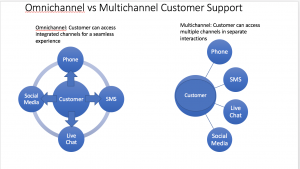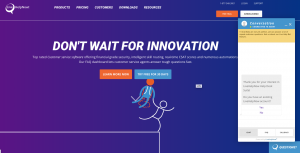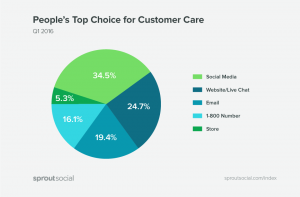Imagine calling your friend one day to talk about a problem you’re having with your mother.
You call, chat, and explain the problem to her. You discuss your feelings and possible solutions. Then you feel a bit better, you hang up the phone and you both go on with your day.
Then later that evening your mother calls and you have another argument. Upset, you text the friend to whom you spoke earlier, eager to discuss the latest development in the conflict. But your friend has no idea what you’re talking about. “You’re having a problem with your mother?” she texts. “Tell me what’s going on.”
Confused, you probably worry about your friend’s memory, mental health, or assume she’s just messing with you. This just doesn’t make any sense, right?
Well, no it doesn’t. It doesn’t make any sense in healthy friendships and it shouldn’t make sense in the business world either.
Yet, we’ve all had those conversations with different customer service agents from the same company. We had to explain the problem we had over and over again simply because we spoke to a different agent before. Or maybe because we changed the communication channel from e-mail to live chat or phone.
That is an example of poor omnichannel customer service.
Well I can say there is no faking omnichannel. I’ve got a three week open case with a major phone company right now…had a scheduled call back last night and the rep had ZERO history. Sooo frustrating. #cxchat https://t.co/EbreVPeZUx
— Nate Brown (@CustomerIsFirst) December 20, 2017
So weird. So unhealthy.
While we can be of no help in the case of the forgetful friend, we can offer some solutions when it comes to business omnichannel customer service communications.
In our SmallBizCX19 conversation with customer experience expert and start-up advisor Sue Duris, we discuss the importance of omnichannel customer service implementation into business practices.

Related Post: 8 customer experience experts discuss best practices – SmallBizCX19
Multichannel vs. Omnichannel Customer Service.
Confusing multichannel communications with omnichannel customer service often gets businesses in trouble, Sue says.
Tsk Tsk Don’t be confusing #multichannel with #omnichannel. Unrelated. #CXChat https://t.co/iix3oMKooq
— Sue Duris (@SueDuris) October 31, 2018
Multichannel customer service simply means that a company offers customers opportunities to contact the business through multiple means of communication. There’s an email address, there’s a listed phone number, and maybe even a live chat on the company’s website.
While sometimes emailing a company might yield the same result as live-chatting with an agent, the two channels might not be connected.
It’s similar to the case of your friend who has no clue about what you said over the phone once you text her later that evening. One communication might be completely unattached and unconnected to the other in the case of multichannel customer service.

Source: Simplr
Omnichannel customer service is different. It provides a variety of communication channels. And it also maintains a consistent and effortless experience from one channel to another. In other words, no matter what channel a customer uses to communicate, all channels work as one consistent stream of communication.
Similar to our example of your friend discussing your problem with your mother over the phone and text, customers expect consistent and seamless communication through all channels. Surprisingly most of the time they do not receive it.
[ctt template=”3″ link=”ShzJe” via=”no” ]According to Customer Think statistics, 75% of consumers expect a consistent experience wherever they engage, be it web, social media web or in person. However, 65% of respondents are frustrated with inconsistent experiences when they are using multiple channels. (CustomerThink)[/ctt]
Frustrated customers are definitely not happy customers.
To ease those frustrations, companies might want to take a look at omnichannel customer service as a way to improve customer engagement, experience, and loyalty.
Here’s why and how.
The Benefits of Omnichannel Customer Service
“Everything points towards [the fact that] omnichannel is the way to go,” Sue says.
So what are the benefits of omnichannel customer service?
Throughout our conversation, we identify three major positives of the practice. All three correlate closely and overall make a business more successful.
Omnichannel customer service promotes proactive customer engagement.
It’s not a secret that proactive customer engagement is a winning strategy in business practices, both big and small. When companies interact with clients in a proactive manner, customers are more likely to do business with the company.
[ctt template=”3″ link=”hQcyq” via=”no” ]A recent Microsoft customer service report says that 68% of consumers say it increases their perception of a brand when companies send them proactive customer service notifications. (Microsoft)[/ctt]
Above all, if a company has all of its communication channels connected into one well-oiled machine, proactive customer service becomes easier to deliver. Omnichannel customer service allows the company to understand its customers, know their history with the company, monitor their interactions, and stay proactively efficient.
Above all, being where the customers are can aid in the process.
Did you know? At any given time, 84% of Americans are shopping for something. Source: @Google #customerexperience #digitalstrategy #businesstips #BizapaloozaChat pic.twitter.com/aGc52kHe5X
— Bizapalooza (@Bizapalooza) December 16, 2019
In addition to brick-and-mortar businesses, online shopping is a major part of today’s consumer environment. Omnichannel customer service can help a business deliver a more personalized and effective customer experience. Whether it’s in person, in a pop-up live chat, or through online FAQs, communications through all the channels should be consistent.
Related Post: 20 Ways To Make The Live Chat Experience More Personal
It’s a perfect time for omnichannel. [According to a recent report by SANA Commerce] customers are purchasing 75% of products online. Digital channels need to be connected – that’s where the customers are doing their work… Almost 50% of customers are using three or more channels. If they’re using that many channels, we need to find a way to seamlessly integrate the channels so we’re getting holistic experience here. (Sue Duris, SmallBizCX19)
In the example below, we can see how LiveHelpNow offers omnichannel customer service options on its homepage. Upon a customer landing on the page, a chat window appears on the right. It allows customers to ask questions and get more information. A customer has an option to close the chat, but the “Questions” tab in the corner can reopen the chat at any time.
Other tabs on the page (resources, products, support etc.) offer the visitor more information. Once a customer connects via live chat, a customer service agent is able to see which pages the visitor browsed as well as any previous communication he or she has had with LiveHelpNow.

Source: LiveHelpNow
The customer does not need to explain more than she or he has to because an agent already has a lot of that information. Based on that information an agent has a better ability to help the customer. Now, that’s an effective and proactive omnichannel customer service.
Omnichannel customer service betters customer experience.
In today’s business world customers face many options. Providing excellent customer experience is a must. This trend will only continue in the future.
Customers in the future will insist on experiences that make their lives significantly easier and better. The companies that will win their business will adapt, not by just proclaiming that customer experience is a priority, but by embedding a customer focus into every aspect of their business. (Blake Morgan, author of Customer of the Future)
Omnichannel customer service is one way to make customers feel like a business knows them well like a local shop owner would know its regulars.
Imagine an agent saying, “Hey, we see you purchased our new software upgrade last week. How is that working out? Is that what you’re calling about today?”
That’s a great example of a company knowing its customers well and making them feel good during an interaction.
Or…
“Oh, we see you contacted us earlier this month about your internet connection. It was slow and we sent a technician out. Is everything working well now?”
That’s another good example.
The customer doesn’t have to explain or repeat herself. The agent and the customer can now have quicker communication and come to a resolution faster.
Omnichannel customer service ensures customer-centricity. Customer-centricity drives customer experience, which drives customer success, which drives profitability which drives growth. (Sue Duris, SmallBizCX19)
Omnichannel customer service creates customer loyalty.
In our example with the clueless friend, how likely would you be to remain friends with her if she continued such behaviors on a consistent basis? Probably not very likely.
Your loyalty to such a bad friend would decrease and you would stop being friends with her.
So the same thinking goes for companies with bad customer service. If you continue to be a bad friend to your customers, chances are they will leave you and go elsewhere. And some probably won’t give you a second chance after one time.
[ctt template=”3″ link=”pryT9″ via=”no” ]33% of Americans say they’ll consider switching companies after just a single instance of poor service. (HelpScout)[/ctt]
According to recent statistics, omnichannel communication really impacts the bottom line for a business, Sue says. Retention rate can go as high as 89% vs. an all-industry average of only 35%.
As we discussed, omnichannel customer service betters customer experience. With better experiences, customers are more likely to return and do more business with a company.
Best tools to use for implementation.
Switching focus to omnichannel customer service can be a challenge.
82% of B2B professionals find it challenging to use omnichannel. That’s what happens in the multi-channel world. And 36% blame “channel conflict” and the communication challenges created by siloed organizations. (Sue Duris, SmallBizCX19)
Thankfully, there are plenty of tools available.
- Ticket management systems. These are a great tool to keep track of all of your customer issues, communications, interactions, and information about each client.
- Social media customer service. In today’s world customers control their communications with companies. They also don’t go online. They live online. It’s only natural for them to want customer service through social media. Stay on top of these communications to create a consistent omnichannel customer service.

Source: Sprout Social
- Journey mapping. There’s no better way to get to know your customers and the way they communicate with your company than to map their journey. Queen of journey mapping, Annette Franz has comprehensive guides that help businesses go through this process.
Don’t miss my interview with Jeff @Toister: Why Journey Mapping is the Backbone of Customer Experience Management https://t.co/EIGf6vWUpU #custexp #custserv #cxdesign #empathy #journeymapping #serviceblueprint #cx pic.twitter.com/V7xC9YXCup
— Annette Franz, CCXP (@annettefranz) December 9, 2019
- Feedback collection and follow up. Feedback collection is an important communication channel in itself. Collecting feedback from your customers in real-time or as soon as possible following the service can give a business valuable insights on customer experience. Tools such as feedback kiosks, email and post-live-chat surveys, and online review trackers can all be of great help.
Bottom Line:
In conclusion, omnichannel customer service betters customer experience. It promotes proactive customer engagement. And it creates customer loyalty. With the right tools in hand, businesses can take their customer communications to the next level by connecting all their available channels.
So there is no reason to be a clueless bad friend to your clients.




